Note
Go to the end to download the full example code.
Brainstorm Elekta phantom dataset tutorial#
Here we compute the evoked from raw for the Brainstorm Elekta phantom tutorial dataset. For comparison, see [1] and the original Brainstorm tutorial.
# Authors: Eric Larson <larson.eric.d@gmail.com>
#
# License: BSD-3-Clause
# Copyright the MNE-Python contributors.
import matplotlib.pyplot as plt
import numpy as np
import mne
from mne import find_events, fit_dipole
from mne.datasets import fetch_phantom
from mne.datasets.brainstorm import bst_phantom_elekta
from mne.io import read_raw_fif
print(__doc__)
The data were collected with an Elekta Neuromag VectorView system at 1000 Hz
and low-pass filtered at 330 Hz. Here the medium-amplitude (200 nAm) data
are read to construct instances of mne.io.Raw.
Opening raw data file /home/circleci/mne_data/MNE-brainstorm-data/bst_phantom_elekta/kojak_all_200nAm_pp_no_chpi_no_ms_raw.fif...
Read a total of 13 projection items:
planar-0.0-115.0-PCA-01 (1 x 306) idle
planar-0.0-115.0-PCA-02 (1 x 306) idle
planar-0.0-115.0-PCA-03 (1 x 306) idle
planar-0.0-115.0-PCA-04 (1 x 306) idle
planar-0.0-115.0-PCA-05 (1 x 306) idle
axial-0.0-115.0-PCA-01 (1 x 306) idle
axial-0.0-115.0-PCA-02 (1 x 306) idle
axial-0.0-115.0-PCA-03 (1 x 306) idle
axial-0.0-115.0-PCA-04 (1 x 306) idle
axial-0.0-115.0-PCA-05 (1 x 306) idle
axial-0.0-115.0-PCA-06 (1 x 306) idle
axial-0.0-115.0-PCA-07 (1 x 306) idle
axial-0.0-115.0-PCA-08 (1 x 306) idle
Range : 47000 ... 437999 = 47.000 ... 437.999 secs
Ready.
Data channel array consisted of 204 MEG planor gradiometers, 102 axial magnetometers, and 3 stimulus channels. Let’s get the events for the phantom, where each dipole (1-32) gets its own event:
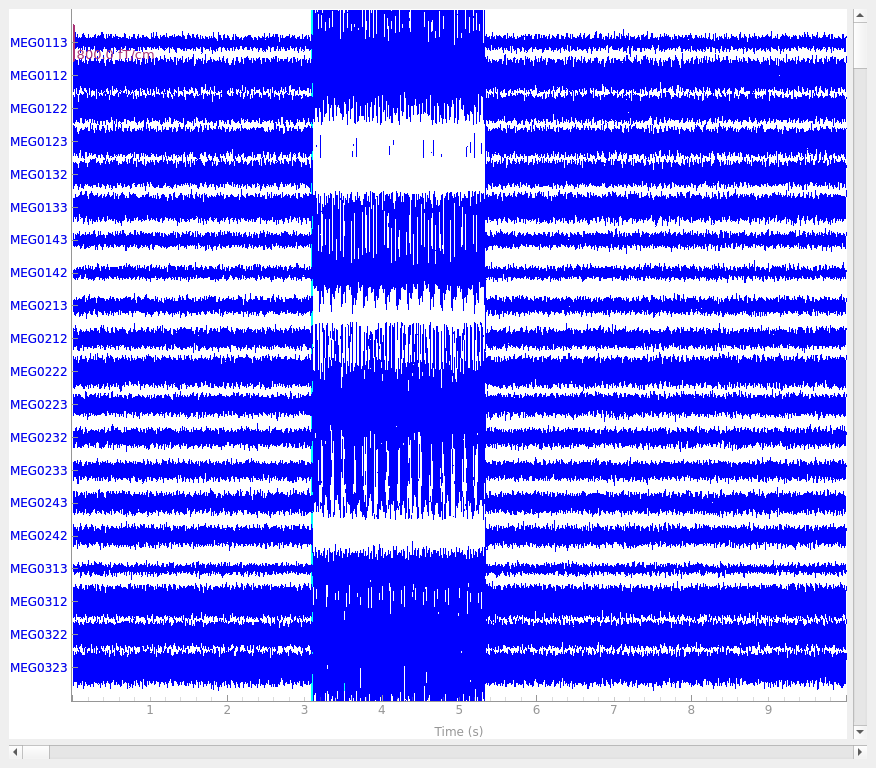
Finding events on: STI201
645 events found on stim channel STI201
Event IDs: [ 1 2 3 4 5 6 7 8 9 10 11 12 13 14
15 16 17 18 19 20 21 22 23 24 25 26 27 28
29 30 31 32 256 768 1792 3840 7936]
Using qt as 2D backend.
The data has strong line frequency (60 Hz and harmonics) and cHPI coil noise (five peaks around 300 Hz). Here, we use only the first 30 seconds to save memory:
raw.compute_psd(tmax=30).plot(
average=False, amplitude=False, picks="data", exclude="bads"
)
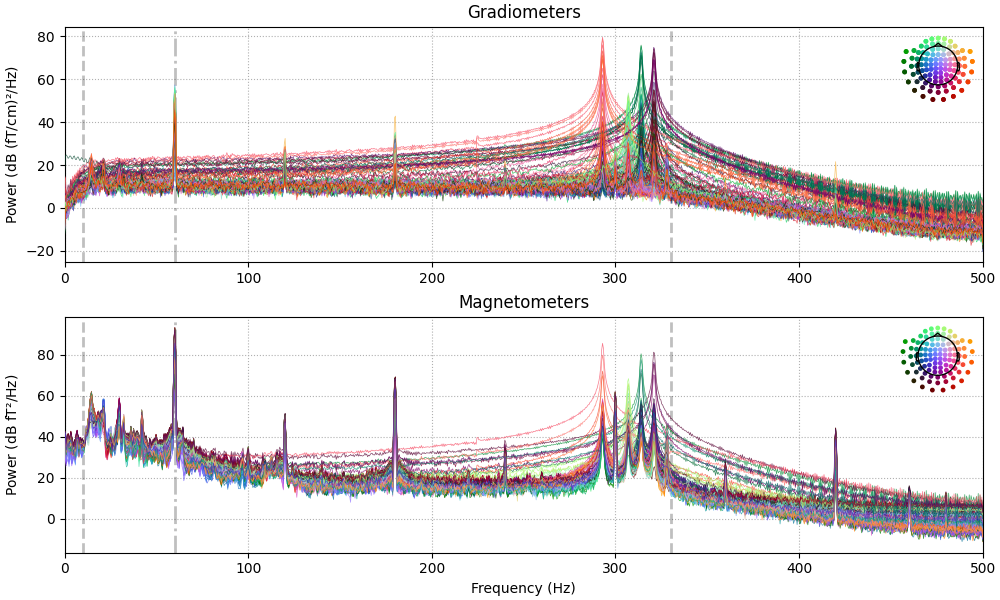
Effective window size : 2.048 (s)
Plotting power spectral density (dB=True).
Our phantom produces sinusoidal bursts at 20 Hz:
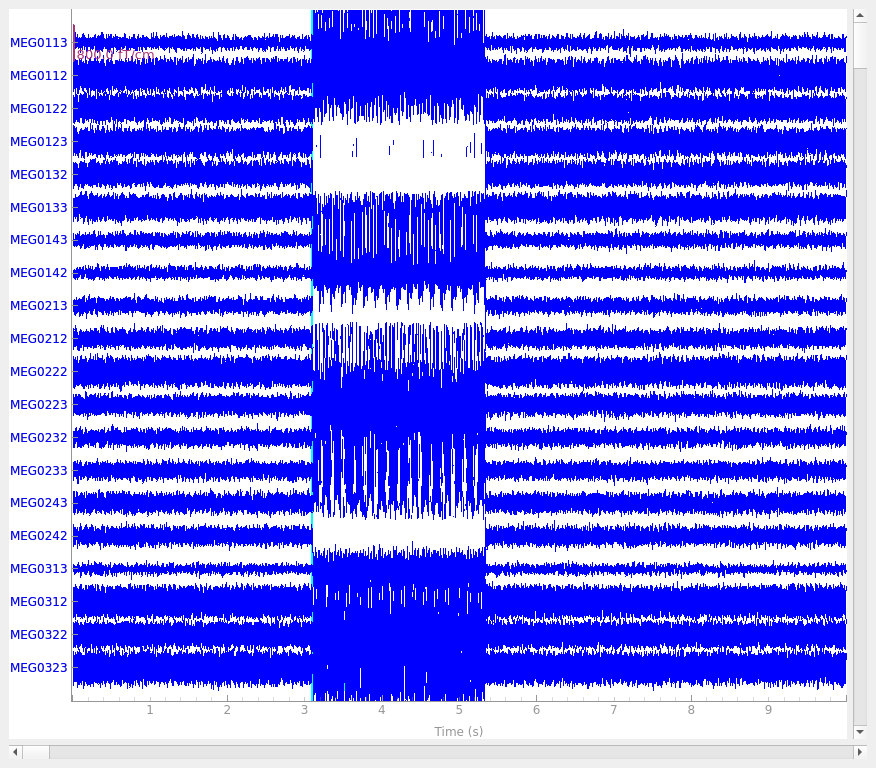
Now we epoch our data, average it, and look at the first dipole response. The first peak appears around 3 ms. Because we low-passed at 40 Hz, we can also decimate our data to save memory.
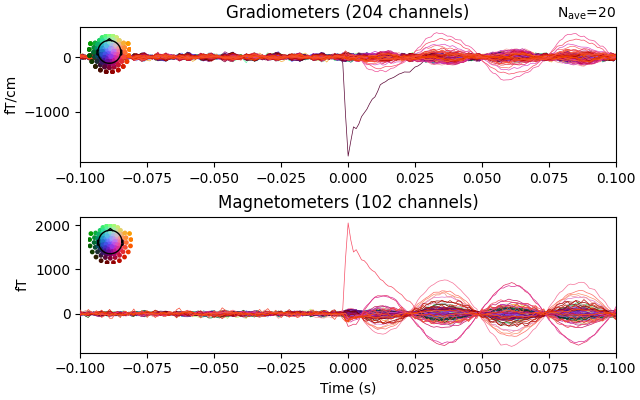
Not setting metadata
640 matching events found
Setting baseline interval to [-0.1, -0.05] s
Applying baseline correction (mode: mean)
Created an SSP operator (subspace dimension = 13)
13 projection items activated
Let’s use a sphere head geometry model and let’s see the coordinate alignment and the sphere location. The phantom is properly modeled by a single-shell sphere with origin (0., 0., 0.).
Even though this is a VectorView/TRIUX phantom, we can use the Otaniemi
phantom subject as a surrogate because the “head” surface (hemisphere outer
shell) has the same geometry for both phantoms, even though the internal
dipole locations differ. The phantom_otaniemi scan was aligned to the
phantom’s head coordinate frame, so an identity trans is appropriate
here.
subjects_dir = data_path
fetch_phantom("otaniemi", subjects_dir=subjects_dir)
sphere = mne.make_sphere_model(r0=(0.0, 0.0, 0.0), head_radius=0.08)
subject = "phantom_otaniemi"
trans = mne.transforms.Transform("head", "mri", np.eye(4))
mne.viz.plot_alignment(
epochs.info,
subject=subject,
show_axes=True,
bem=sphere,
dig=True,
surfaces=("head-dense", "inner_skull"),
trans=trans,
mri_fiducials=True,
subjects_dir=subjects_dir,
)

0 files missing from phantom_otaniemi.txt in /home/circleci/mne_data/MNE-brainstorm-data/bst_phantom_elekta
Equiv. model fitting -> RV = 0.00385873 %%
mu1 = 0.943736 lambda1 = 0.139585
mu2 = 0.66496 lambda2 = 0.685424
mu3 = -0.0416425 lambda3 = -0.0146395
Set up EEG sphere model with scalp radius 80.0 mm
Using lh.seghead for head surface.
Getting helmet for system 306m
Channel types:: grad: 204, mag: 102
Let’s do some dipole fits. We first compute the noise covariance, then do the fits for each event_id taking the time instant that maximizes the global field power.
# here we can get away with using method='oas' for speed (faster than "shrunk")
# but in general "shrunk" is usually better
cov = mne.compute_covariance(epochs, tmax=bmax)
mne.viz.plot_evoked_white(epochs["1"].average(), cov)
data = []
t_peak = 0.036 # true for Elekta phantom
for ii in event_id:
# Avoid the first and last trials -- can contain dipole-switching artifacts
evoked = epochs[str(ii)][1:-1].average().crop(t_peak, t_peak)
data.append(evoked.data[:, 0])
evoked = mne.EvokedArray(np.array(data).T, evoked.info, tmin=0.0)
del epochs
dip, residual = fit_dipole(evoked, cov, sphere, n_jobs=None)
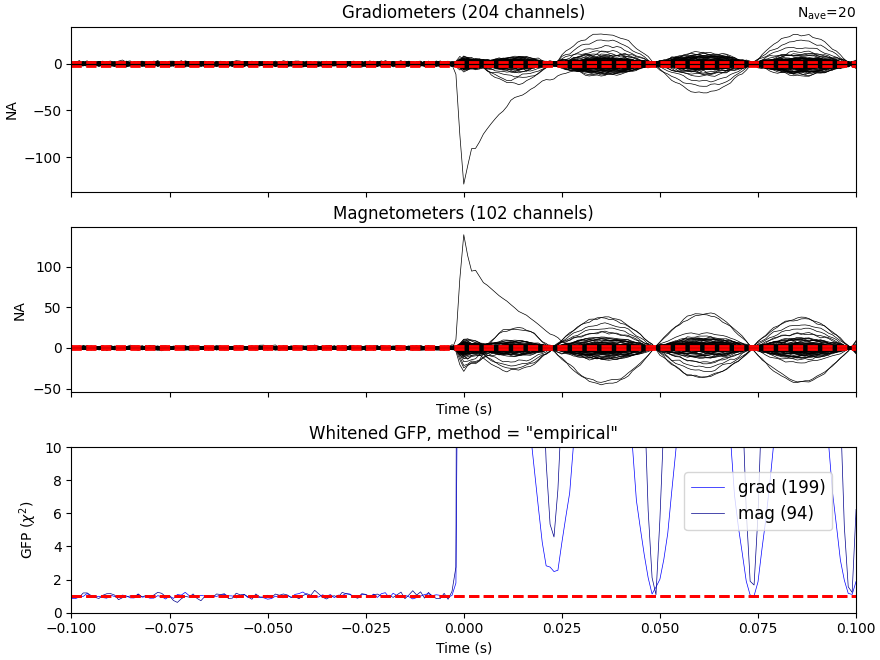
Loading data for 20 events and 201 original time points ...
0 bad epochs dropped
Loading data for 20 events and 201 original time points ...
0 bad epochs dropped
Loading data for 20 events and 201 original time points ...
0 bad epochs dropped
Loading data for 20 events and 201 original time points ...
0 bad epochs dropped
Loading data for 20 events and 201 original time points ...
0 bad epochs dropped
Loading data for 20 events and 201 original time points ...
0 bad epochs dropped
Loading data for 20 events and 201 original time points ...
0 bad epochs dropped
Loading data for 20 events and 201 original time points ...
0 bad epochs dropped
Loading data for 20 events and 201 original time points ...
0 bad epochs dropped
Loading data for 20 events and 201 original time points ...
0 bad epochs dropped
Loading data for 20 events and 201 original time points ...
0 bad epochs dropped
Loading data for 20 events and 201 original time points ...
0 bad epochs dropped
Loading data for 20 events and 201 original time points ...
0 bad epochs dropped
Loading data for 20 events and 201 original time points ...
0 bad epochs dropped
Loading data for 20 events and 201 original time points ...
0 bad epochs dropped
Loading data for 20 events and 201 original time points ...
0 bad epochs dropped
Loading data for 20 events and 201 original time points ...
0 bad epochs dropped
Loading data for 20 events and 201 original time points ...
0 bad epochs dropped
Loading data for 20 events and 201 original time points ...
0 bad epochs dropped
Loading data for 20 events and 201 original time points ...
0 bad epochs dropped
Loading data for 20 events and 201 original time points ...
0 bad epochs dropped
Loading data for 20 events and 201 original time points ...
0 bad epochs dropped
Loading data for 20 events and 201 original time points ...
0 bad epochs dropped
Loading data for 20 events and 201 original time points ...
0 bad epochs dropped
Loading data for 20 events and 201 original time points ...
0 bad epochs dropped
Loading data for 20 events and 201 original time points ...
0 bad epochs dropped
Loading data for 20 events and 201 original time points ...
0 bad epochs dropped
Loading data for 20 events and 201 original time points ...
0 bad epochs dropped
Loading data for 20 events and 201 original time points ...
0 bad epochs dropped
Loading data for 20 events and 201 original time points ...
0 bad epochs dropped
Loading data for 20 events and 201 original time points ...
0 bad epochs dropped
Loading data for 20 events and 201 original time points ...
0 bad epochs dropped
Created an SSP operator (subspace dimension = 13)
Setting small MEG eigenvalues to zero (without PCA)
Reducing data rank from 306 -> 293
Estimating covariance using EMPIRICAL
Done.
Number of samples used : 32640
[done]
NOTE: pick_types() is a legacy function. New code should use inst.pick(...).
Computing rank from covariance with rank=None
Using tolerance 3.9e-11 (2.2e-16 eps * 204 dim * 8.5e+02 max singular value)
Estimated rank (grad): 199
GRAD: rank 199 computed from 204 data channels with 5 projectors
Computing rank from covariance with rank=None
Using tolerance 3.5e-14 (2.2e-16 eps * 102 dim * 1.6 max singular value)
Estimated rank (mag): 94
MAG: rank 94 computed from 102 data channels with 8 projectors
Created an SSP operator (subspace dimension = 13)
Computing rank from covariance with rank={'grad': 199, 'mag': 94, 'meg': 293}
Setting small MEG eigenvalues to zero (without PCA)
Created the whitener using a noise covariance matrix with rank 293 (13 small eigenvalues omitted)
BEM : <ConductorModel | Sphere (3 layers): r0=[0.0, 0.0, 0.0] R=80 mm>
MRI transform : identity
Sphere model : origin at ( 0.00 0.00 0.00) mm, rad = 0.1 mm
Guess grid : 20.0 mm
Guess mindist : 5.0 mm
Guess exclude : 20.0 mm
Using normal MEG coil definitions.
Noise covariance : <Covariance | kind : full, shape : (306, 306), range : [-1.8e-21, +2.2e-21], n_samples : 32639>
Coordinate transformation: MRI (surface RAS) -> head
1.000000 0.000000 0.000000 0.00 mm
0.000000 1.000000 0.000000 0.00 mm
0.000000 0.000000 1.000000 0.00 mm
0.000000 0.000000 0.000000 1.00
Coordinate transformation: MEG device -> head
0.976295 -0.211976 0.043756 0.29 mm
0.206488 0.972764 0.105326 0.57 mm
-0.064891 -0.093794 0.993475 5.41 mm
0.000000 0.000000 0.000000 1.00
0 bad channels total
Read 306 MEG channels from info
105 coil definitions read
Coordinate transformation: MEG device -> head
0.976295 -0.211976 0.043756 0.29 mm
0.206488 0.972764 0.105326 0.57 mm
-0.064891 -0.093794 0.993475 5.41 mm
0.000000 0.000000 0.000000 1.00
MEG coil definitions created in head coordinates.
Decomposing the sensor noise covariance matrix...
Created an SSP operator (subspace dimension = 13)
Computing rank from covariance with rank=None
Using tolerance 5.8e-11 (2.2e-16 eps * 306 dim * 8.6e+02 max singular value)
Estimated rank (mag + grad): 293
MEG: rank 293 computed from 306 data channels with 13 projectors
Setting small MEG eigenvalues to zero (without PCA)
Created the whitener using a noise covariance matrix with rank 293 (13 small eigenvalues omitted)
---- Computing the forward solution for the guesses...
Making a spherical guess space with radius 72.0 mm...
Filtering (grid = 20 mm)...
Surface CM = ( 0.0 0.0 0.0) mm
Surface fits inside a sphere with radius 72.0 mm
Surface extent:
x = -72.0 ... 72.0 mm
y = -72.0 ... 72.0 mm
z = -72.0 ... 72.0 mm
Grid extent:
x = -80.0 ... 80.0 mm
y = -80.0 ... 80.0 mm
z = -80.0 ... 80.0 mm
729 sources before omitting any.
178 sources after omitting infeasible sources not within 20.0 - 72.0 mm.
Source spaces are in MRI coordinates.
Checking that the sources are inside the surface and at least 5.0 mm away (will take a few...)
8 source space point omitted because of the 5.0-mm distance limit.
170 sources remaining after excluding the sources outside the surface and less than 5.0 mm inside.
Go through all guess source locations...
[done 170 sources]
---- Fitted : 0.0 ms
---- Fitted : 1.0 ms
---- Fitted : 2.0 ms
---- Fitted : 3.0 ms
---- Fitted : 4.0 ms
---- Fitted : 5.0 ms
---- Fitted : 6.0 ms
---- Fitted : 7.0 ms
---- Fitted : 8.0 ms
---- Fitted : 9.0 ms
---- Fitted : 10.0 ms
---- Fitted : 11.0 ms
---- Fitted : 12.0 ms
---- Fitted : 13.0 ms
---- Fitted : 14.0 ms
---- Fitted : 15.0 ms
---- Fitted : 16.0 ms
---- Fitted : 17.0 ms
---- Fitted : 18.0 ms
---- Fitted : 19.0 ms
---- Fitted : 20.0 ms
---- Fitted : 21.0 ms
---- Fitted : 22.0 ms
---- Fitted : 23.0 ms
---- Fitted : 24.0 ms
---- Fitted : 25.0 ms
---- Fitted : 26.0 ms
---- Fitted : 27.0 ms
---- Fitted : 28.0 ms
---- Fitted : 29.0 ms
---- Fitted : 30.0 ms
---- Fitted : 31.0 ms
Projections have already been applied. Setting proj attribute to True.
32 time points fitted
Do a quick visualization of how much variance we explained, putting the data and residuals on the same scale (here the “time points” are the 32 dipole peak values that we fit):
fig, axes = plt.subplots(2, 1)
evoked.plot(axes=axes)
for ax in axes:
for text in list(ax.texts):
text.remove()
for line in ax.lines:
line.set_color("#98df81")
residual.plot(axes=axes)
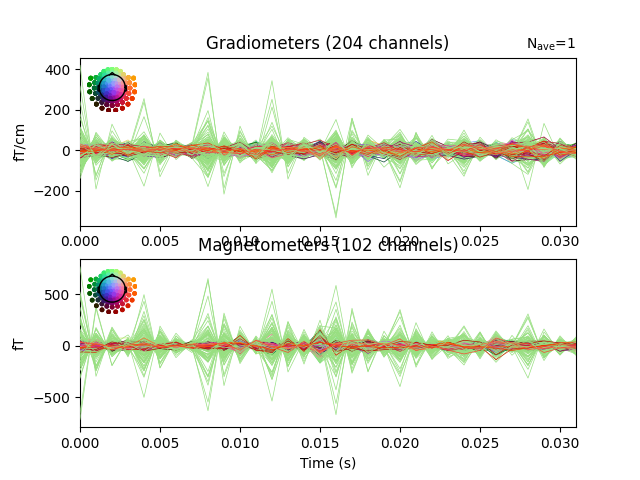
Now we can compare to the actual locations, taking the difference in mm:
actual_pos, actual_ori = mne.dipole.get_phantom_dipoles()
actual_amp = 100.0 # nAm
fig, (ax1, ax2, ax3) = plt.subplots(
nrows=3, ncols=1, figsize=(6, 7), layout="constrained"
)
diffs = 1000 * np.sqrt(np.sum((dip.pos - actual_pos) ** 2, axis=-1))
print(f"mean(position error) = {np.mean(diffs):0.1f} mm")
ax1.bar(event_id, diffs)
ax1.set_xlabel("Dipole index")
ax1.set_ylabel("Loc. error (mm)")
angles = np.rad2deg(np.arccos(np.abs(np.sum(dip.ori * actual_ori, axis=1))))
print(f"mean(angle error) = {np.mean(angles):0.1f}°")
ax2.bar(event_id, angles)
ax2.set_xlabel("Dipole index")
ax2.set_ylabel("Angle error (°)")
amps = actual_amp - dip.amplitude / 1e-9
print(f"mean(abs amplitude error) = {np.mean(np.abs(amps)):0.1f} nAm")
ax3.bar(event_id, amps)
ax3.set_xlabel("Dipole index")
ax3.set_ylabel("Amplitude error (nAm)")
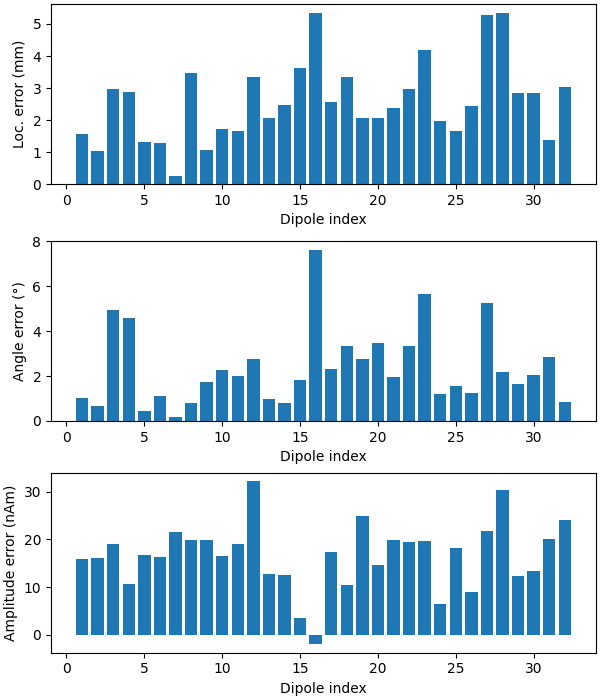
mean(position error) = 2.6 mm
mean(angle error) = 2.4°
mean(abs amplitude error) = 16.9 nAm
Let’s plot the positions and the orientations of the actual and the estimated dipoles
actual_amp = np.ones(len(dip)) # fake amp, needed to create Dipole instance
actual_gof = np.ones(len(dip)) # fake GOF, needed to create Dipole instance
dip_true = mne.Dipole(dip.times, actual_pos, actual_amp, actual_ori, actual_gof)
fig = mne.viz.plot_alignment(
evoked.info,
trans,
subject,
bem=sphere,
surfaces={"head-dense": 0.2},
coord_frame="head",
meg="helmet",
show_axes=True,
subjects_dir=subjects_dir,
)
# Plot the position and the orientation of the actual dipole
fig = mne.viz.plot_dipole_locations(
dipoles=dip_true, mode="arrow", subject=subject, color=(0.0, 0.0, 0.0), fig=fig
)
# Plot the position and the orientation of the estimated dipole
fig = mne.viz.plot_dipole_locations(
dipoles=dip, mode="arrow", subject=subject, color=(0.2, 1.0, 0.5), fig=fig
)
mne.viz.set_3d_view(figure=fig, azimuth=70, elevation=80, distance=0.5)
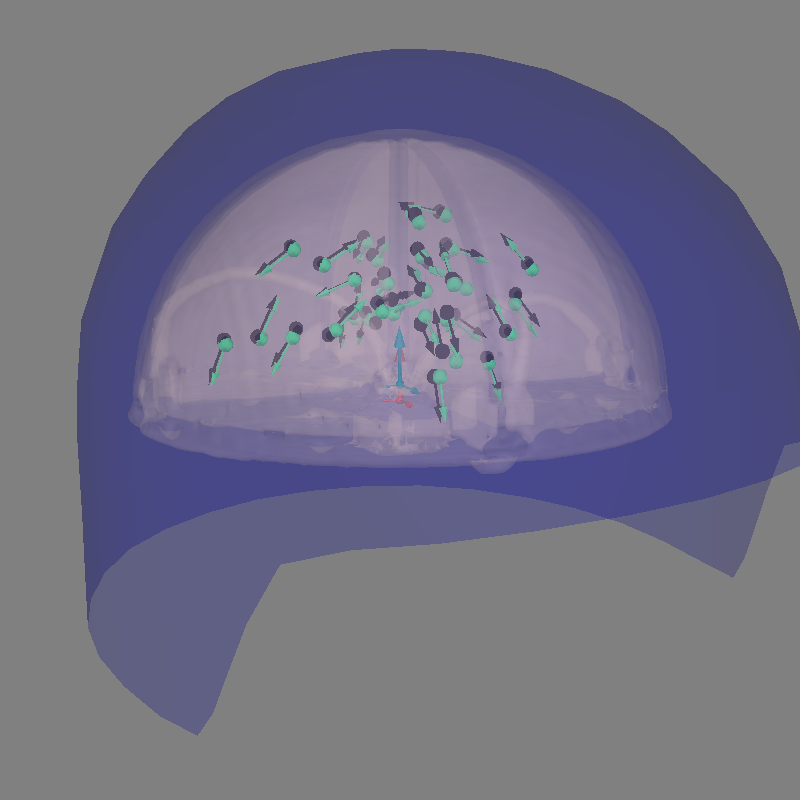
Using lh.seghead for head surface.
Getting helmet for system 306m
References#
Total running time of the script: (1 minutes 6.269 seconds)